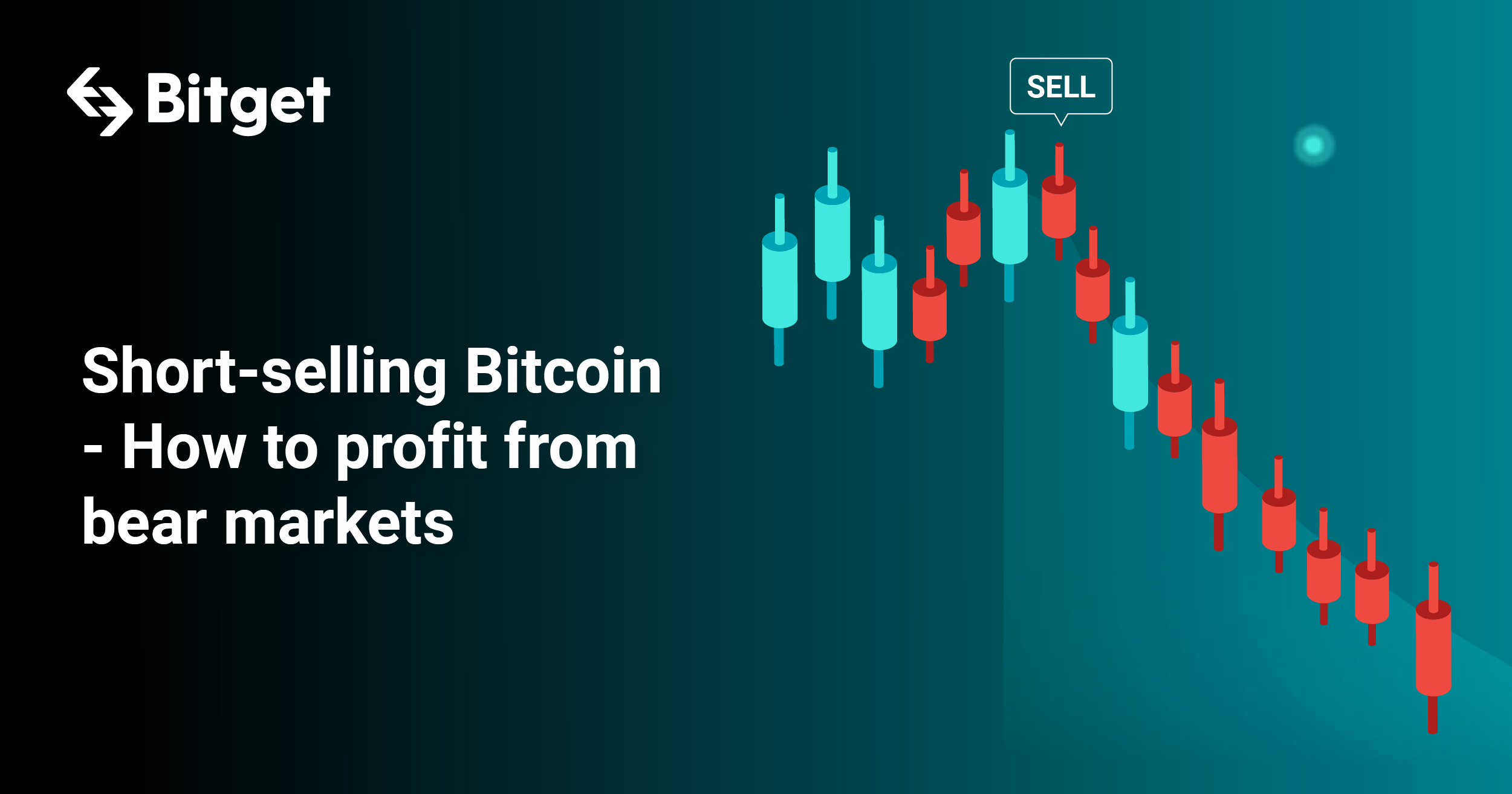
Short-selling Bitcoin — How to Profit From Bear Markets
As a retail investor and trader, it is important to be aware of the overall crypto market conditions to be able to adapt or switch between strategies accordingly. The current market conditions are bearish and don’t seem to be showing any signs of reversal yet due to several factors. This article will guide you through the short-selling Bitcoin as well as other tools on Bitget to profit from this bear market.
Global Market Overview
The past two and a half years have marked history due to the exceptional events with the Covid-19, crisis that is now considered to be a Black Swan event. This led to exceptional market conditions with high levels of volatility that in turn created simultaneous bull and bear runs in multiple sectors as a K-shaped recovery took place. The global economy isn’t at its strongest and most markets have turned bearish. In this sense, the cryptocurrency market makes no exception.
Bitcoin overview
Bitcoin is currently 9 months from its all-time high and on a steady downtrend since the fourth quarter of 2021 with a slight resilience turned to consolidation and bounce throughout the first quarter of 2022 before resuming its decline throughout Q2 and hitting unseen since the fourth quarter of 2020.

It is safe to say that crypto-currency is in a bear market and facing a new crypto-winter with returns of -17.3%, -15.56%, -37.32% respectively for the months of April, May, and June.
Although one of Bitcoin's core initial values was to be independent from the traditional financial system, it no longer is the case due to the influx of large amounts of corporate and institutional capital. A direct consequence of this is the increase in levels of correlation between Bitcoin and major financial indexes such as SP500 and Nasdaq that put downward pressure on the price of Bitcoin. The correlation with these indexes hit all-time highs throughout the month of May with 0.88 between Bitcoin and Nasdaq 100 and 0.74 with the SP500 of on 25 May 2022.
Furthermore, the rising cost of energy has impacted the way miners manage their reserves. In fact, they tend to hold but have started selling some of their mined coins in anticipation of rising energy prices resulting in additional downward pressure on the cryptocurrency markets.
At a minimum, the short-term outlook is bearish, but it is still possible to seek gains even within such uncertain market conditions. To this effect, multiple tools and methods are at your disposal depending on risk tolerance, time horizon and investment goals. It is essential to harness these factors as they will condition your plan, strategy and tools that are best suited for you.
Suggestions to profit from the bear market
Hodling
Is it even possible to talk about a bear market or crypto winter without mentioning the one and only most famous word in the crypto industry? HODL, a word born from a typo…
HODLING is the concept of holding cryptos at hand through time without selling-off any. This is a long-term approach and can be compared to a dragon keeping its treasure without letting anyone or anything touch it. This is a long-term passive strategy with little to no effort involved after the initial crypto purchase is made. The key is to hold major cryptocurrency’s that have shown stability through time and/or which deliver high value from a fundamental viewpoint (ex: use cases, tokenomics...). The risks of this strategy are linked to the exposure over time and the underlying assets performance. In fact, uncertainty increases over long time periods, and the price can widely fluctuate and even go to 0. The major downfall of simply hodling crypto is that returns are 100% dependent on the variation of the assets price in relation to the purchasing price. This can be problematic when analysing the real inflation-adjusted performance.
Staking
Staking is the closest solution to the traditional markets risk-free return solutions such as sovereign bonds usually offering low yet stable interest rates.
Staking is the process of placing cryptos within a consensus mechanism that helps stabilize and contributes to the blockchains operating. In exchange, a reward fixed by a given rate in the same cryptocurrency is distributed on a periodic basis. This is an excellent method to be combined with the above hodling as it is also a passive strategy and applies a compounding effect to cryptocurrency. This is a medium to long-term strategy for which the main risk lies with the choice of exchange through which the staking is done. Centralised Exchanges (CEX) are exposed to the risk of being hacked or going bankrupt. Furthermore, because the return is based on the number of coins and distributed as such, the exposure to the underlying coins value remains as in HODLING.
Scenario 1: Neutral – The price of the asset remains stable
Capital Allocation: 100 Polkadot (DOT) purchased at $10 per unit for a total of $1000; Staking APY: 2%/year; Return: 2 DOT = $20 Total Capital: $1020; +2%
Scenario 2 : Optimal – The price of the asset increases
Capital Allocation: 100 Polkadot (DOT) purchased at $10 per unit for a total of $1000; Staking APY: 2%/year; New $DOT price: $20 Return: 2 DOT = 2% ; $40 = 4% Total Capital: 102 x $20 = $2040 ; +104%
Scenario 3: Sub-optimal – The price of the asset decreases
Capital Allocation: 100 Polkadot (DOT) purchased at $10 per unit for a total of $1000; Staking APY: 2%/year; New $DOT Price: $5 Return: 2 DOT = 2% ; -$10 = -1% Total Capital: 102 x $5 = $510 ; -49%
Join Bitget Savings and Staking NOW!
Accumulation via DCA
Maybe you bought a coin during the bull market at a high price and although it has great value, its price action isn’t reflecting it! This might be an opportunity for accumulating and scaling into your position!
Accumulating using a dollar-cost-averaging (DCA) strategy is the principle of trying to build a sizable position at a reduced cost. To do so, multiple buy orders are placed at different intervals below one another to execute purchases. This is an active strategy that demands some level of effort in analysing the asset and defining the ideal purchasing levels. The advantage of this strategy is that as prices go lower, your position gets bigger as you get more crypto units at each purchase and your average cost of the position decreases. The additional advantage is that you are not risking 100% of your capital straight away as you scale in progressively and can always decide to stop following the strategy. The risk is that as the price is going down, there is no guarantee it will go back up, so it is recommended to stick to major cryptocurrencies with strong fundamentals and proven robustness.
Scenario 1: One-time Bitcoin Purchase
Capital Allocation: $1,000
Initial Purchase 1: 100% at $25,000
Average Cost: $25,000;
Position Size: 0.04 Bitcoins.
Scenario 2: Dollar Cost Averaging on Bitcoin
Capital Allocation: $1,000;
Initial Purchase 1: 20% at $25,000; Purchase 2: 30% at $20,000; Purchase 3: 30% at $15,000; Purchase 4: 20% at $12,000;
Average Cost: $25,000 x 0.20 + $20,000 x 0.30 + $15,000 x 0.30 + $12,000 x 0.20 = $17,900;
Position Size: 0.06 Bitcoins.
Between scenario 1 and scenario 2, although the initial capital input is the same, the outcome is very different. In fact, spreading out the purchases reduced the average cost by $7,100 and granted the acquirer an extra 0.02 Bitcoins, approximately 50% more.
You can do DCA manually with Bitget Spot Trading, or you can also try our Bitget Spot Martingale AI Strategy. Martingale AI enables automated trading after traders set risk appetites and investment frequency based on parameters recommended by Bitget’s proprietary AI.
Trading: Shorting Futures
So far, passive, or semi-passive approaches to making money in the bear market on a medium to long-term horizon have been presented but it is possible to trade or speculate on cryptocurrencies' next move to the up or downside via futures.
Futures are risky products that enable one to take leveraged long or short positions and realize gains if the price of the underlying asset moves in the desired direction: upwards for longs and downwards for shorts. The rewards can be as high as the risks taken, and losses are limited to the capital allocated although receiving a margin call followed by a liquidation is not fun. There are three main approaches when it comes to trading futures.
Option 1: Trading with the trend
As the name implies, by trading with the trend in a bear market, only shorts will be taken realizing gains as the price drops from the entry price. This tends to be the most likely scenario in a bear trend as prices decrease over time. The risk is that the trend reverses or an inadequate level of leverage combined with high volatility leads to liquidation. Short to medium-term positions with low to moderate leverage can be applied to capture some gains and reduce losses.
Option 2: Trading against the trend
As the name implies, by trading against the trend in a bear market, only longs will be taken realizing gains as the price rises above the entry price. This is a riskier approach in a bear market as it involves timing the market to a certain extent. In fact, taking a long position is most profitable as the trend is reversing or as a bounce occurs following a steep decline in prices. In either case, a robust trading system and strategy need to be in place to capitalise on these usually short-lived movements.
Option 3: Trading within a range
It is common knowledge that no matter the market conditions, the market does not indefinitely move in a linear manner. In fact, there may be periods in time where the market makes a lateral movement called consolidation before resuming the trend. During this period, it is possible to take multiple positions switching between long and shorts to capture gains, but the risk is being stuck in a position whilst the trend resumes. It is important whilst applying this approach to have the key price levels in mind to optimize entries and exits with take profits and stop-loss orders.

Tradingview: BTCUSD 4H Chart pointing out price movements
The above chart shows recent past price action on the Bitcoin 4H chart with emphasis on the different phases: Downwards move, Lateral Move Pullbacks. This example is to give an idea and illustrates the potential and opportunities available by trading futures. Please note that this example is subject to lookback and the patterns aren’t as obvious.
Read more guidelines on What You Need To Know About Shorting?, Bitget’s Coin-Margined Futures, and Bitget’s USDT-Margined Futures.
Conclusion
It is essential to note that the maturity stage for cryptocurrency and blockchain environment is far more advanced than in the previous crypto bear markets due to major corporate and institutional adoption that is bringing changes to the space. Furthermore, the world is in a state of global crisis meaning all asset classes are impacted but with this comes opportunities in all markets including cryptocurrencies. Utilising combining some of the trading tools offered by Bitget to develop a plan and create wealth according to individual time horizon preferences and risk aversion will help get through the tough crypto winter ahead.
Disclaimer: The opinions expressed in this article are for informational purposes only. This article does not constitute an endorsement of any of the products and services discussed or investment, financial, or trading advice. Qualified professionals should be consulted prior to making financial decisions.

- GetAgent Rolls Out Major Upgrade—Enhanced Membership Perks2025-12-05 | 5m

